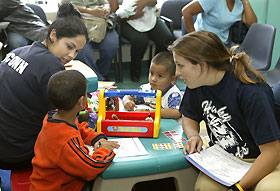For more archives, go to the Advance Archive/Search Page.
Program Introduces Concepts of Nutrition
to Children Through Books
 |
Rachel Fazio, left, and Anna Poutasse, UConn students who are part of the Husky Reads nutrition education program, work with children as they color at the Women, Infants, and Children Center in Hartford. |
As busy parents hustle their children in and out of the Women, Infants, and Children Center in Hartford, student volunteers from UConn’s nutrition education program, Husky Reads, greet them with smiles and toys.
The students stay there for two hours reading and playing with the children, while their parents wait to receive food stamps and other benefits from the center. Each Husky Reads activity has a basic nutritionally based message. One of the books is narrated by different fruits, for example, and there is a coloring activity where the main characters are the main food groups.
The program, launched five years ago, was the idea of nutritional sciences professor Ann Ferris. It is run by Meredith Poehlitz, Husky Nutrition Program education coordinator.
This year it was selected from among 16 nominees to receive the state Department of Higher Education Community Service Award. With the $500 prize, the program organizers bought T-shirts for the volunteers, to give the students a team identity that the children can easily recognize, says Ferris.
There are usually about 50 students participating in various Husky Reads programs each semester. In addition to the reading program at the WIC Center, some volunteers read to children in hospital waiting rooms, and others help out with cooking activities at Girls Inc., a once-a-week after-school program organized by the Salvation Army.
Many of the volunteers are freshmen and sophomores, and they are drawn from a variety of majors.
The students work hard, says Ferris. They volunteer their time in four-hour blocks, and attend training to understand different parenting styles and learn how to read to children.
Husky Reads is a service learning program, says Ferris, that balances the needs of the agency and the needs of the students. Although the students volunteer their time, they gain many educational benefits.
The students get almost as much out of the program as the families they help, says Rachel Glennon, a graduate student in nutritional sciences.
“They get clinical experience,” she says. “They get to play with the kids, and they get to broaden their cultural horizons in ways they would be unable to do in a normal college setting.”
The program helps sensitize the students to the way families in poverty live, says Ferris. It gives them an understanding of how much these families love their children, for example.
“It’s surprising how into it the kids are,” says Hilary Orr, a senior majoring in human development and family studies, who has been volunteering for two years. “They’re happy to see us and that makes me happy.”
Orr volunteers with Girls Inc., where girls from eight to 12 years old learn basic cooking skills and simple recipes, such as Ants on a Log – peanut butter and raisins on celery sticks.
“What we are doing is very basic nutritional education for low-income families,” says Glennon. “It increases food awareness, but it also increases literacy levels and even friendliness.”
When Husky Reads first started, they probed for negative experiences the students encountered, Ferris says, but there were none.
“It’s something to do if you love kids,” says Rachel Fazio, a sophomore majoring in family studies. “It’s fun to hang out and make them smile.” Fazio adds that the students try to be positive role models for the children.
Ferris says Husky Reads is so popular with students that the program no longer recruits. In fact, some students have been turned away because there is not enough transportation. Volunteers who don’t have a car on campus are paired with juniors and seniors who do.
The program has a high volunteer retention rate, she says. Many students, who first volunteered with the reading program, move on to teach cooking classes at Girls Inc. and eventually do an internship for credit.
Six students in nutritional sciences are doing the program for credit. They meet once a month and keep journals expressing their thoughts and reactions to the families.
“We really appreciate the students we take on each semester,” Glennon says. “They put in a lot of effort. We love that. We wouldn’t be successful without their efforts and the quality of their work.”

